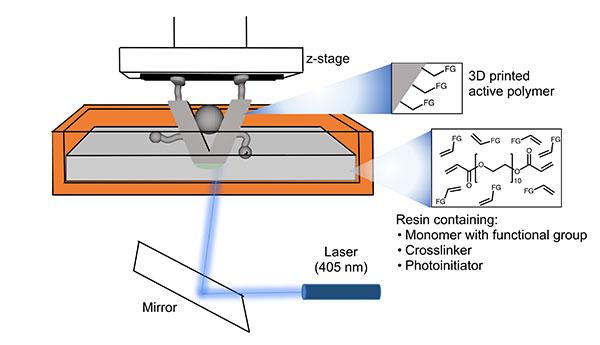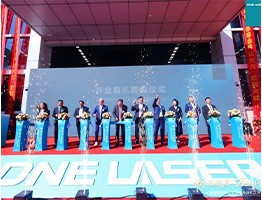One-Step 3D Laser Printing of Catalysts
source:Photonics
release:Nick
keywords: 3D printing;Laser 3D Printing; Additive manufacturing
Time:2017-11-03
AMES, Iowa, Nov. 2, 2017 — A 3D laser printing process that creates a chemically active catalytic object in a single step has opened the door to more efficient ways to produce catalysts for complex chemical reactions in a wide scope of industries.

Catalysts can be built in one step by directly shining a laser through a bath of customized resins that polymerize and harden layer by layer. Courtesy of Ames Laboratory, U.S. Department of Energy.
While 3D printing has found applications in many areas, its use as a way to control chemical reactions, or catalysis, is relatively new. Current production of 3D catalysts typically involves various methods of depositing the chemically active agents onto preprinted structures.
The U.S. Department of Energy's Ames Laboratory method combines the structure with the chemistry in only one step using inexpensive commercial 3D printers. The structures are designed in a computer and built directly by shining a laser through a bath of customized resins that polymerize and harden layer by layer. The final product that emerges has catalytic properties already intrinsic to the object.
"The monomers, or building blocks that we start with, are designed to be bifunctional. They react with light to harden into the three-dimensional structure, and still retain active sites for chemical reactions to occur," said Sebastián Manzano, a graduate student in the Department of Chemistry at Iowa State.
The catalysts built with the Ames Laboratory method demonstrated success in several reactions common to organic chemistry. They are also adaptable with further post-processing, making possible multistep reactions.

Ames Laboratory has developed a one-step 3D-printing process for catalysts that can be customized to any shape — in this demonstration, the Ames Laboratory logo design. Courtesy of Ames Laboratory, U.S. Department of Energy
"We can control the shape of the structure itself — what we call the macroscale features — and the design of the catalyst — the nanoscale features — at the same time," said Igor Slowing, a scientist in heterogeneous catalysis at the U.S. Department of Energy's Ames Laboratory. "This opens up many possibilities to rapidly produce structures custom designed to perform a variety of chemical conversions."

Catalysts can be built in one step by directly shining a laser through a bath of customized resins that polymerize and harden layer by layer. Courtesy of Ames Laboratory, U.S. Department of Energy.
While 3D printing has found applications in many areas, its use as a way to control chemical reactions, or catalysis, is relatively new. Current production of 3D catalysts typically involves various methods of depositing the chemically active agents onto preprinted structures.
The U.S. Department of Energy's Ames Laboratory method combines the structure with the chemistry in only one step using inexpensive commercial 3D printers. The structures are designed in a computer and built directly by shining a laser through a bath of customized resins that polymerize and harden layer by layer. The final product that emerges has catalytic properties already intrinsic to the object.
"The monomers, or building blocks that we start with, are designed to be bifunctional. They react with light to harden into the three-dimensional structure, and still retain active sites for chemical reactions to occur," said Sebastián Manzano, a graduate student in the Department of Chemistry at Iowa State.
The catalysts built with the Ames Laboratory method demonstrated success in several reactions common to organic chemistry. They are also adaptable with further post-processing, making possible multistep reactions.

Ames Laboratory has developed a one-step 3D-printing process for catalysts that can be customized to any shape — in this demonstration, the Ames Laboratory logo design. Courtesy of Ames Laboratory, U.S. Department of Energy
"We can control the shape of the structure itself — what we call the macroscale features — and the design of the catalyst — the nanoscale features — at the same time," said Igor Slowing, a scientist in heterogeneous catalysis at the U.S. Department of Energy's Ames Laboratory. "This opens up many possibilities to rapidly produce structures custom designed to perform a variety of chemical conversions."
NEWS
 4th Collaboration! What Brought the Global Laser Academic Guru to Chinese Univs & Leading Firms?
4th Collaboration! What Brought the Global Laser Academic Guru to Chinese Univs & Leading Firms? DNE Laser Foshan Smart Manufacturing Base Grand Opening: New Brand Image Starts New Journey
DNE Laser Foshan Smart Manufacturing Base Grand Opening: New Brand Image Starts New Journey Live: DMP GBA Expo – Laser Hard Tech Leads Industrial Smart Manufacturing New Wave
Live: DMP GBA Expo – Laser Hard Tech Leads Industrial Smart Manufacturing New Wave Scientists Develop Palm-sized Short-pulse Laser System: Efficiency Increased to 80%
Scientists Develop Palm-sized Short-pulse Laser System: Efficiency Increased to 80% Global LiDAR Giants Engage in Escalating Patent Wars
Global LiDAR Giants Engage in Escalating Patent Wars
INTERVIEW
 Shi Lei (Hipa Tech): Focus on Domestic Substitution, Future Layout in High-End Laser Micromachining
Shi Lei (Hipa Tech): Focus on Domestic Substitution, Future Layout in High-End Laser Micromachining Optizone Technology: 17 Years Devoted to Optics – High-Power Optics Mass-Production Pioneer
Optizone Technology: 17 Years Devoted to Optics – High-Power Optics Mass-Production Pioneer Zhuojie Laser: Breaking barriers via tech breakthroughs, aiming to lead high-end light sources
Zhuojie Laser: Breaking barriers via tech breakthroughs, aiming to lead high-end light sources Dr. Sun Linchao: Pioneer and Leader in China's Field of Medical Aesthetic Laser Therapy
Dr. Sun Linchao: Pioneer and Leader in China's Field of Medical Aesthetic Laser Therapy Guo Guangcan, CAS Academician & USTC Professor: Four Decades Chasing Quantum "Light"
more>>
Guo Guangcan, CAS Academician & USTC Professor: Four Decades Chasing Quantum "Light"
more>>
